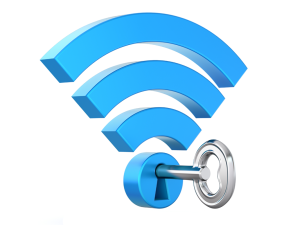Is My WiFi Secure?
Many households have wireless routers, and that number is rapidly growing every day. The convenience of being able to access your wireless connection anywhere in the office or home is especially hard to resist with the surge in popularity of mobile devices such as smartphones, notebooks, and tablets.

This brings up a question that many have asked us, “Is my Wi-Fi secure?” In this post we will hopefully answer that and other questions about Wi-Fi security!
The Basics
Home Wi-Fi networks are created and accessed through a device known as a wireless router. The router typically has several security settings such as the administrator password, the wireless security key and encryption method. To access these settings you must have the administrator username & password, and the router’s IP address. This should be provided in the router’s instruction manual or user’s guide. The IP address will look similar to “192.168.1.1” or “192.168.1.254.”
Open your browser and enter the IP address in the address bar. You should be asked for your administrator username and password. At that point you should have access to your router’s security settings and whether or not it is currently secured. Many wireless routers will also come with a setup CD that allows you to customize your wireless router settings via an application run from a computer. If your wireless router came from your Internet Service Provider, the IP address, username and password are often printed on the router itself.
The Nuts & Bolts
Now that you have accessed your router’s security settings, you can adjust them to make your router more secure.
- First of all and probably most importantly, change the administrator username & password from the default! Default passwords for devices are easily found online or are set to something like admin user with a password of admin. Use a password which is easy for you to remember but would be difficult for anyone else to guess, ideally something with a combination of letters and numbers. Don’t make them anything obvious like “admin123” or “wifipassword.” Once you have changed them, REMEMBER them! If you forget your administrator password you will have to reset your router, which means totally setting it up again from scratch.
- Change your SSID (Service Set Identifier). This is the name that identifies your network. Make it unique to you, so it will be hard for anyone to guess the make/model of your router and its defaults. This will be the name your wireless devices will see when you try to connect.
- Enable encryption. Encryption scrambles messages sent over Wi-Fi so that they can’t be read easily. There are different forms of encryption, but it’s recommended that you use the Wi-Fi Protected Access II (WPA2) version because it is more secure than other versions such as Wired Equivalent Privacy (WEP) and WPA. Many devices will display the type of encryption method used by the router when you try to access it.
Optional
- Enable MAC filtering. A MAC Address is a unique identifier given to a network adapter when manufactured. You can enable a “white-list” of MAC Addresses. Then only the MAC Addresses that you specifically put into this list will be able to access your Wi-Fi. If a friend comes over and wants to use your wireless network, you will have to enter their devices MAC Address into your “white-list” so they can access your network. This is only recommended for users with networking know-how that might have older devices that don’t support WPA2 or other special circumstances.
In Conclusion
Wireless security is preventing unauthorized access to your network via your wireless router. By following the above suggestions, you can ensure that your router’s security is a “tougher nut to crack” for any would-be hackers.
The crew at Geek Easy Computers are wireless experts! If you have any questions, issues, or are wanting to add a wireless router to your home or small office, give us a call or stop in anytime. We’d love to assist you!
Geek Easy Computers – Making Technology Easier
 |
Adonis Pointer is a photographer, a collector of vintage razors, and a certified technology geek! Adonis has been involved in computer technology since well, a LONG time! He has been involved in nearly every aspect of the industry from sales to repair to training to consulting. As the Social Media Manager he writes the majority of the posts on the Geek Easy Computers blog. |